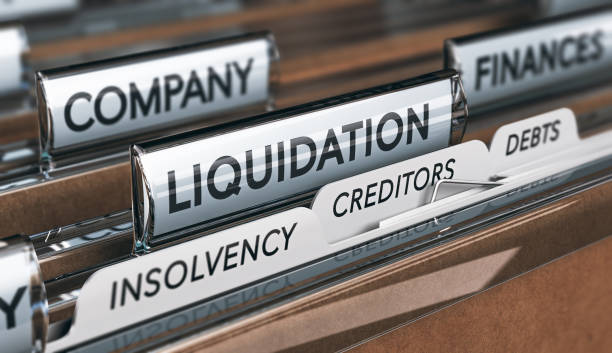
To liquidate a company, a business is wound up, shut down, and removed from the Companies House registry. When a business cannot pay its obligations, it sometimes goes through a liquidation process in which its assets are auctioned to satisfy creditors. In either scenario, the goal is to “liquidate” the business.
The liquidation procedure may be voluntary or it may be a court order. The Articles of Organization in each business and Dutch commercial law both govern the process of liquidating a Dutch corporation. Furthermore, the process has a number of phases, some of which can be initiated by a single shareholder action.
In the Netherlands, there are two to liquidate a company: the standard and the accelerated procedures. Continue reading for a step-by-step explanation of the liquidation procedure in the Netherlands from liquidation professionals.
What Is Liquidation?
In the fields of finance and economics, liquidation means the act of closing down a firm and dividing its assets among claimants. It is an occurrence that typically takes place when a business is bankrupt, or unable to make its debt payments on time. Once business activities come to an end, the residual assets are distributed to shareholders and creditors according to the order of priority of their claims. Liquidation is the process whereby the sale of subpar items at a price less than their cost to the company or less than their market value.

Read: What is a Certificate of Good Standing and Reasons Your Business Needs It?
How to Liquidate a Company?
Standard Practice
The director(s) must summon a general meeting of shareholders. This will help stakeholders to vote on dissolving the business and selling off its assets and liabilities. The directors move from the office to liquidators and choose the keeper of all the company’s records and files.
If the business has a governing board, this body should endorse the shareholders’ agreement to liquidate the corporation. During the time of the dissolving, “in liquidate” must be added to all publications and official statements of or by the firm. It is customary for former executives to surrender their own corporate obligations following the dissolution resolution.
Deregistration
The Trade Registry of the Chamber of Commerce must get a deregistration. The final account and the resolution to dissolve and liquidate must be recorded with the Trade Registry; Mailing or hand-delivery of the deregistration form are both acceptable;
Forms are accessible in English, However, the liquidators must fill them out in Dutch; – When you request to be deregistered, the Trade Registration will inform the tax authorities. You might need to reach a financial agreement with the Netherlands Revenue and Customs Administration. Afterwards, liquidators make an announcement in a daily publication with wide distribution. The announcement must indicate the location of the final account and dissemination plan for public view; –
The liquidator(s) shall terminate existing active contracts, licenses, registration of domain names, and other subscriptions. Furthermore, they shall cause all property known to the liquidator(s) to be dispersed. The liquidators inform The Trade Registry of the liquidation’s conclusion, the identity and location of the person in charge of the records.
The entire dissociation lasts around three months. If it seems that there are still assets to be liquidated, the dissolution may be “reopened.” Also, it can reopen that the claim of a creditor or benefactor has yet to be taken into consideration.
Read: Step By Step Guide on How to Register your Business in the UK
In this situation, the business “revives,” but solely to recover the balance. The liquidator(s) may take back any assets that were left over if the beneficiaries were given an excessive amount. Once the business is dissolved, the corporate books and documents must be kept with the designated custodian for seven years.
Accelerated Method
Through a “distribution in advance,” which requires prior consent from the relevant district court, the process for dissolving your firm can be expedited in the Netherlands.
Only in cases where the liquidator(s) can show that they’re aware of all creditors, the beneficiaries of the corporation’s total amount are few, and everyone guarantees- For example, by signing a guarantee, that they will return a fraction of the allocation in beforehand if a creditor still surfaces or resistance is actually brought.
In order to liquidate a company, the director(s) must call a general meeting of investors, select the liquidator(s), and designate a custodian for the firm’s corporate books and documents. Even if no further liquidation is necessary, the liquidator(s) must nonetheless produce a final statement of the dissolution

The liquidators must submit deregistration to the Chamber of Commerce’s Trade Registry. Once all assets accessible to the liquidator(s) have been allocated, the corporation will no longer exist. If an unknown creditor surfaces or there is any dispute within the two months that follow the publication, the assets dispersed beforehand may need to be (partially or entirely) retrieved, leading to a redistribution of assets.
The liquidator(s) must issue a notice regarding the liquidation in a widely distributed daily newspaper. The liquidator(s) shall be personally accountable for the loss suffered if repayment is impossible and some creditor(s) remain unpaid. The company books and documents will stay preserved with the designated custodian for a period of seven years.
Read: Step By Step Guide to the Ajman Free Zone Company Registration
How Long Does it take in the Netherlands to Liquidate a Company?
When the liquidator determines that there are no longer any commodities available for the dissolution process, a notice of the liquidation must typically be published in a publication with national distribution. The District Court must provide a statement of non-objection in two months. This states that states that there aren’t any challenges to the liquidation. At the completion of the liquidation and the company’s demise, the liquidator must file the dissolution at the Trade Register. In some circumstances, the process takes several months to complete. If one of the entitled entities requests it, the liquidation procedure may be resumed in specific circumstances.
Final Verdict
Liquidation is the process that a business goes through when it becomes insolvent or cannot pay its debts. A firm is shut down during liquidation, and its assets are distributed among claimants. In order of importance, proceeds from the sale of property are distributed to shareholders and creditors. Another term for liquidation is the act of getting rid of a stake in securities, typically by selling it for cash.
Related Articles you Might be Interested in:
How to Access the Dutch Trade Registry of the Chamber of Commerce Online
Turbo-liquidation of a Company/Legal Entity – Dutch Registry Smart Portal




